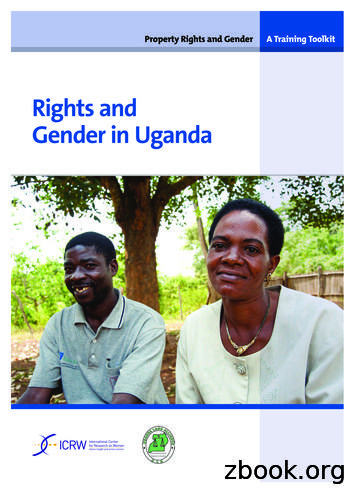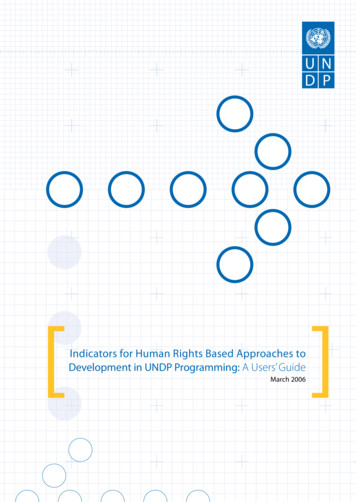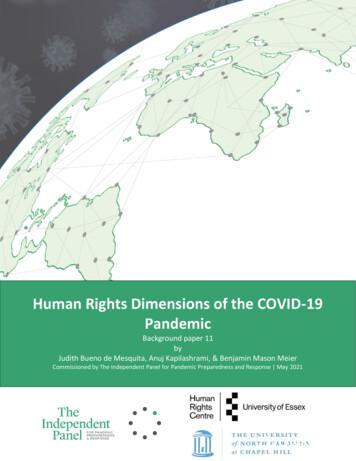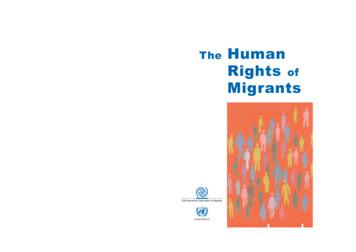Drug Policy And Human Rights: The Canadian Context
Drug policy and human rights: the Canadian contextSubmission to the Office of the UN High Commissioner for Human Rights,pursuant to Human Rights Council Resolution 28/28, UN Doc. A/HRC/28/L.22 (2015)from:Canadian HIV/AIDS Legal NetworkCanadian Drug Policy CoalitionBritish Columbia Civil Liberties AssociationVancouver Area Network of Drug UsersCanadian Students for Sensible Drug PolicyInternational Centre for Science in Drug PolicyCanadian Aboriginal AIDS NetworkPrisoners with HIV/AIDS Support Action NetworkCanadian Association of Nurses in HIV/AIDS CareCanadian Treatment Action CouncilInteragency Coalition on AIDS and DevelopmentCanadian Public Health AssociationCATIEMay 15, 2015I.Human rights and drug policyCanada is a party to the three main UN drug control conventions, which aim to control illicit drugs byreducing supply and demand, in particular through requiring States Parties to adopt varying degrees ofprohibitions and sanctions on a range of designated controlled substances, while also providing somedegree of (often contested) flexibility for States Parties in their approach.1 Yet Canada must also fulfill itsdomestic constitutional obligations under the Canadian Charter of Rights and Freedoms, as well as thoseunder international human rights law, including the International Covenant on Economic, Social andCultural Rights, the International Covenant on Civil and Political Rights, the Convention against Tortureand Other Cruel, Inhuman or Degrading Treatment or Punishment and other core human rights treaties,all of which Canada has ratified.When poorly developed and implemented, drug policies can lead to serious human rights violations,including police harassment and violence, arbitrary detention, disproportionate sentencing andincarceration, torture and other ill-treatment, discrimination, and violations of the right to health. Yetthis flies in the face of “the health and welfare of mankind” which is ostensibly the foundational concern1United Nations, Single Convention on Narcotic Drugs (1961), as amended by the 1972 Protocol amending theSingle Convention on Narcotic Drugs; United Nations, Convention on Psychotropic Substances (1971); UnitedNations, Convention against Illicit Traffic in Narcotic Drugs and Psychotropic Substances (1988).
of the international drug control regime2 -- or, as described by the United Nations Office on Drug andCrime (UNODC), that “one of the stated aims of the international drug control conventions is to protectthe health of individuals and society from the dangerous effects of drug use.”3 Ill-advised drug policy cannot only exacerbate the harms sometimes associated with the use of controlled substances, but alsocontribute to the risk of other preventable harms, including blood-borne infections such as HIV andhepatitis C virus (HCV) and overdoses. Under international law, Canada must respect, protect and fulfilthe right to life4 and the right of “everyone to enjoy the highest attainable standard of physical andmental health.”5 Under the latter obligation, States Parties have a binding legal obligation to take stepsto realize the right to health, including steps “necessary for prevention, treatment and control ofepidemic, endemic and other diseases” and “the creation of conditions which would assure to allmedical services and medical attention in the event of sickness.”6Such human rights obligations bind the state in its response to drugs. Indeed, UN Member States at theCommission on Narcotic Drugs (CND) have repeatedly reaffirmed that their responses to “the worlddrug problem” must be carried out “in full conformity with the purposes and principles of the Charter ofthe United Nations and other provisions of international law and, in particular, with full respect for allhuman rights and fundamental freedoms ”7 They have also specifically recognized that “there is aninsufficient emphasis on human rights and dignity in the context of drug demand reduction efforts, inparticular regarding access to the highest attainable standard of health services,” and therefore there isa need to “ensure that drug demand reduction measures respect human rights and the inherent dignityof all individuals and facilitate access for all drug users to prevention services and health-care and socialservices, with a view to social reintegration.”8 The CND has reiterated this more recently, with statesagain recognizing “the need to base programmes for the treatment and rehabilitation of drug usedisorders on scientific evidence while respecting human rights and human dignity.”9The UN General Assembly has also repeatedly recognized that all aspects of States’ responses to drugsmust be in conformity with human rights standards – including in the Political Declaration on “the worlddrug problem” adopted by the 1998 UN General Assembly Special Session on Drugs,10 then again adecade later following the global review of the implementation of that Declaration,11 and most recentlyin its December 2014 resolution regarding its upcoming special session on the subject in 2016.12 These2E.g., see the first clause of the Preamble to the 1961 Single Convention.UNODC, From coercion to cohesion: Treating drug dependence through health care, not punishment. Discussionpaper based on a scientific workshop held in Vienna from 28 to 30 October 2009, 2010, p. 1.4International Covenant on Civil and Political Rights (1966), 993 UNTS 3, Article 6.5International Covenant on Economic, Social and Cultural Rights, Article 12(1).6International Covenant on Economic, Social and Cultural Rights, Article 12(2).7CND Resolution 51/12 (2008), UN Doc. E/CN.7/2008/15; Political Declaration and Plan of Action onInternational Cooperation towards an Integrated and Balanced Strategy to Counter the World Drug Problem, inCommission on Narcotic Drugs, Report of the Fifty-second Session, ECOSOC Official Reports, 2009, Supp. No. 8, UNDoc. E/2009/28, E/CN.7/2009/12 (pp. 37ff). See also subsequent resolutions: CND Resolution 53/2 (2010), UN Doc.E/CN.7/2010/18; UN Doc. E/CN.7/2010/18 (pp. 8-10); CND Resolution 53/8 (2010), UN Doc. E/CN.7/2010/18 (pp.24-26).8CND, Political Declaration (2009), supra, at paras. 5, 6(a).9CND Resolution 54/5 (2011), in Commission on Narcotic Drugs, Report on the fifty-fourth session, ECOSOC OfficialReports 2011, Supp. No. 8, UN Doc. E/CN.7/2011/15 (p. 12).10UN General Assembly, Resolution S-20/2 (1998), UN Doc. A/RES/S-20/2.11UN General Assembly, Resolution 64/182 (2009), UN Doc. A/RES/64/182.12UN General Assembly, Resolution 69/200 (2014), UN Doc. A/RES/69/200.32
are but a few of the numerous occasions on which UN Member States have declared that drug controlefforts must comply with human rights.13Despite these repeated pronouncements, in implementing the international drug control conventions,most countries have adopted a predominantly repressive approach to drug policy, focusing heavily onreducing supply through law-enforcement strategies and losing sight of one of the conventions’ mainobjectives to promote the “health and welfare of mankind.”14 This is perhaps not surprising, given theoverall orientation of the conventions themselves toward measures of prohibition and punishment; theflexibilities that do exist, to some degree, under the conventions have often been disregarded ornarrowly interpreted by Member States (with some important exceptions).It is now increasingly recognized that repressive drug control laws and policies around the world havefailed to fight crime or reduce drug use and drug-related harm, but have rather contributed to mountinghuman rights violations against people who use drugs and fueled the HIV and HCV epidemic byundermining access to harm reduction services and treatment for people who use drugs. It is in thiscontext that international experts, including the Global Commission on Drug Policy15 and the GlobalCommission on HIV and the Law,16 as well as the UN Special Rapporteur on the right to the highestattainable standard of health,17 have urged States to end failed policies and adopt an approach to drugpolicy respectful of human rights and public health principles. In particular, the Global Commission onDrug Policy has called on States to prioritize community health and safety in designing drug policies byending the criminalization and marginalization of people who use drugs, investing in evidence-basedprevention, health and treatment for those in need (including harm reduction services), focusingrepressive actions on violent criminal organizations in ways that undermine their powers and reach,while prioritizing the reduction of violence and allowing and encouraging diverse experiments in legallyregulating markets.18The 2016 UN General Assembly Special Session on Drugs (UNGASS) represents an important opportunityfor the international community to engage in an open dialogue on drug policy and finally move awayfrom the “war on drugs” – whose many harms include systemic and widespread violations of humanrights. Because human rights and drug policy are inevitably linked, the Office of the High Commissionerfor Human Rights (OHCHR) and the Human Rights Council each has an important role to play in this13See also the following General Assembly Resolutions: Resolution 60/178 (2005), UN Doc. A/RES/60/178;Resolution 61/183 (2006), UN Doc. A/RES/61/183; Resolution 62/176 (2007), UN Doc. A/RES/62/176; Resolution63/197, UN Doc. A/RES/63/197 (2008); Resolution 65/233 (2010), UN Doc. A/RES/65/233; Resolution 66/183(2011), UN Doc. A/RES/66/183; Resolution 67/193 (2012); UN Doc. A/RES/67/193; Resolution 68/197 (2013), UNDoc. A/RES/68/197.14Preamble to the 1961 Single Convention on Narcotic Drugs.15Global Commission on Drug Policy, War on drugs. Report of the Global Commission on Drug Policy, 2011; TheWar on drugs and HIV/AIDS. How criminalization of drug use fuels the global pandemic. Report of the GlobalCommission on Drug Policy, 2012; The Negative impact of the war on drugs on public health: the hidden hepatitis Cepidemic. Report of the Global Commission on Drug Policy, 2013.16Global Commission on HIV and the Law, Risks, Rights and Health, July 2012.17UN, General Assembly, Report of the Special Rapporteur on the right of everyone to the enjoyment of the highestattainable standard of physical and mental health, A/65/255 (August 6, 2010).18Global Commission on Drug Policy, War on Drugs: Report of the Global Commission on Drug Policy, 2011; TheWar on drugs and HIV/AIDS – How criminalization of drug use fuels the global pandemic: Report of the GlobalCommission on Drug Policy, 2012; Global Commission on Drug Policy, Taking control. Pathways to drug policiesthat work, 2014; all online www.globalcommissionondrugs.org.3
discussion. We welcome the March 2015 resolution of the Human Rights Council requesting the OHCHRto prepare a study of this issue, and are pleased to submit this commentary regarding certain humanrights implications of drug policy in the context of a particular Member State.II.Drug policy in Canada: the contextAs described by the Global Commission on Drug Policy, “[p]unitive approaches to drug policy areseverely undermining human rights in every region of the world.”19 Canada is no exception. Humanrights violations continue to occur in the context of Canada’s implementation of a punitive drugstrategy, including violations of the right to life, the right to health, the prohibition on arbitrarydetention and ill treatment, and the right to equality and non-discrimination. The health and otherhuman rights of Indigenous people in Canada continue to be particularly adversely affected.The Government of Canada launched a new National Anti-Drug Strategy in 2007. In contrast withprevious national strategies, which reflected a widespread national consensus among service providers,researchers and affected populations, this new strategy eliminated the long-standing element of harmreduction as part of the Government’s response to drugs, a retrogressive step putting people who usedrugs at increasing risk of harm. Harm reduction includes such evidence-based health services as needleand syringe programs (NSPs) and supervised consumption services (SCS), which prevent overdose andthe transmission of communicable diseases such as HIV and HCV, and can increase access to treatmentand to other health and social services.Instead, the new strategy expanded a punitive approach to drug policy in Canada, with the bulk of newfunding focused on enforcement of criminal prohibitions related to substances scheduled under theControlled Drugs and Substances Act.20 A review conducted in 2009 showed that law enforcementreceived the overwhelming majority of funding for the drug strategy (70%) while prevention (4%),treatment (17%) and harm reduction (2%) combined only received a quarter of the overall funding.21The federal government’s punitive approach to drugs continue to be accompanied by new “tough oncrime” laws, including legislation introducing mandatory minimum sentences for certain drug-relatedoffenses despite health and human rights, and active attempts from the federal government to preventthe implementation of new harm reduction programs across the country.III.Specific human rights concerns resulting from Canada’s approach to drug policyRight to lifeThe hostility of the Government of Canada to harm reduction is costing lives by preventing access toevidence-based health services that prevent overdoses and disease, even where local governments havebeen supporting of their implementation.This hostility has been most evident with regard to Insite, Vancouver’s supervised injection facility,which has decreased deaths from overdose in addition to decreasing syringe-sharing and the risk of HIV19Global Commission on Drug Policy, Taking control. Pathways to drug policies that work, 2014, p. 12.Canadian Drug Policy Coalition, Getting to tomorrow: a report on Canadian drug policy, 2013, online:http://drugpolicy.ca/report/CDPC2013 en.pdf;21K. De Beck et al., “Canada's new federal 'National Anti-Drug Strategy': an informal audit of reported fundingallocation,” International Journal of Drug Policy 2003; 20(2):188-191.204
and HCV transmission, and increasing referrals to addiction treatment services.22 Despite Insite’s proveneffectiveness in protecting the life and health of people who use drugs, the Government signaled itwould likely discontinue the legal exemption from the Controlled Drugs and Substances Act that permitsit to operate without risk of clients or staff being criminally prosecuted for drug possession; thisprompted court actions seeking to preserve the exemption so as to allow Insite to continue operating.The Government then appealed initial court decisions upholding Insite’s exemption as a matter ofconstitutional rights.Finally, in September 2011, the Supreme Court of Canada ruled unanimously that Canada hadunconstitutionally violated the human rights of people with addictions – specifically, the rights to life,liberty and to security of the person protected by Canada’s Charter of Rights and Freedoms.23 The Courtfound that the government’s effective decision to deny an exemption to Insite was “arbitrary,” in that itundermined public health and safety, which are ostensibly the very purposes of Canada’s drug laws. TheCourt said such a decision was also “grossly disproportionate,” since “the potential denial of healthservices and the correlative increase in the risk of death and disease to injection drug users outweighany benefit that might be derived from maintaining an absolute prohibition on possession of illegaldrugs on Insite’s premises.” As the Court declared: “Insite saves lives. Its benefits have been proven.”It ruled that shuttering Insite would constitute an impermissible violation of the human rights of some ofthose who are most vulnerable; the criminal prohibition on drug possession could not be allowed toextend so far as to impede access to such health services for people with addictions. The Courttherefore ordered the Minister to grant an ongoing exemption to Insite to protect these human rights.Several projects to implement supervised consumption services are being considered across Canada.However, Bill C-2, An Act to amend the Controlled Drugs and Substances Act, was introduced by thefederal government in response to the Supreme Court’s ruling in the Insite case. Currently before thefederal Parliament, Bill C-2 will create unreasonable barriers to their implementation. Contrary to theletter and spirit of the Supreme Court of Canada’s decision protecting human rights, the bill providesthat exemptions will only be granted in “exceptional circumstances” and set out onerous conditionspurposely designed to impede the establishment of supervised consumption services.24While data on the number of people dying of overdose in Canada is limited and partial, the availablefigures indicate that overdose deaths due to medical and non-medical drug use are now a significantsource of mortality (e.g., the third leading cause of accidental death in Ontario), with opioid deaths on22For a two-page summary of research findings about Insite, see Urban Health Research Institute, BC Center forExcellence in HIV/AIDS, Insight into Insite, 2010, available oads/docs/ insight into insite.pdf. For a more in-depth view ofresearch studies (including many of the studies cited in this document), see BC Center for Excellence in HIV/ AIDS,Vancouver Coastal Health and Urban Health Research Institute, Findings from the evaluation of Vancouver’s PilotMedically Supervised Safer Injecting Facility – Insite, revised in 2009, available athttp://uhri.cfenet.ubc.ca/images/Documents/ insite report-eng.pdf23Canada (Attorney General) v. PHS Community Services Society, 2011 SCC 44.24Bill C-2, An Act to amend the Controlled Drugs and Substances Act. The text of Bill C-2 is available ?Mode 1&billId 6254806&Language E. For more informationabout Bill C-2 and its implications for the implementation of supervised consumption services in Canada, seeCanadian HIV/AIDS Legal Network, Canadian Drug Policy Coalition, An Injection of Reason: Critical Analysis of BillC-2, 2014 at critical-analysis-of-bill-c-2/5
the rise in recent years in several provinces.25 Other measures, in addition to supervised consumptionservices, can be taken to reduce overdose death, such as making naloxone (a treatment for opioidoverdose recommended by the World Health Organization) more readily available and cost effective andby reducing the barriers to calling emergency services during a drug overdose. But again, current policyand legislation hinder these efforts. For example, because of the way it is regulated, naloxone can onlybe dispensed with a prescription, which limits access to people who use drugs, their family and friends.The criminalization of drug use and possession in Canada also deter witnesses of overdoses from callingemergency services. In the United States, several states have passed “Good Samaritan immunity” laws inrecognition that fear of criminal justice involvement should not be a barrier to calling an ambulance inthe event of an overdose. But there is no such legislation in Canada.26Right to healthAccording to the UN Committee on Economic, Social and Cultural Rights (CESCR), one core aspect of theright to health is the obligation “[t]o ensure the right of access to health facilities, goods and services ona non-discriminatory basis, especially for vulnerable or marginalized groups.”27 Yet the Government ofCanada has opposed evidence-based harm reduction programs and even taken “deliberatelyretrogressive measures,” which the CESCR has noted presumptively violate the right to health.28The most recent surveillance data indicates that 12.8% of new HIV infections in Canada are attributableto injection drug use.29 Harm reduc
Canada is a party to the three main UN drug control conventions, which aim to control illicit drugs by reducing supply and demand, in particular through requiring States Parties to adopt varying degrees of prohibitions and sanctions on a range of designated controlled substances, while also providing some
Rights and gendeR in Uganda · 3 Rights & Human Rights Background Rights The law is based on the notion of rights. Community rights workers need to understand what rights are, where rights come from, and their own role in protecting and promoting rights. Community rights worker
A Human Rights Perspective by David Shiman Raising Children with Roots, Rights and Responsibilities: Celebrating the UN Convention on the Rights of the Child by Lori DuPont, Joanne Foley, and Annette Gagliardi Lesbian, Gay, Bisexual, and Transgender Rights: A Human Rights Perspective by David M. Donahue The Human Rights Education Handbook:
make up the International Bill of Human Rights. The provisions of the two Covenants, as well as other human rights treaties, are legally binding on . of their human rights, for example marriage and the family. 6 WOMEN’S RiGHTS ARE HUMAN RiGHTS The Convention defines d
stream human rights into development projects and to monitor and implement a human rights-based approach (HRBA) to development more generally. From the side of human rights, the demand has come from recognition among the human rights treaty monitoring bodies, the Office of the High Commissioner for Human Rights, and a variety of Special .
human rights impact of COVID-19 and COVID-19 responses on human rights; the role of global health and human rights governance actors, including the WHO, World Health Assembly, Office of the High Commissioner for Human Rights and UN human rights oversight bodies, suggesting areas of action for
consider the human rights dimension of contemporary migration. Under the Universal Declaration of Human Rights (created fifty years ago), human rights are universal (they apply everywhere), indivisible (political and civil rights cannot be separated from social and cultural rights); and inalienable (they cannot be denied to any human beings).
the concept of human rights, this essay will examine the tensions between human rights and state sovereignty, the challenges to the universality of human rights, the enumeration of rights recognized by the international community, and the means available to translate the high aspirations of human rights into practice. II.
member requests a refill of the drug, at which time the member will receive a 60-day supply of the drug. If the Food and Drug Administration deems a drug on our formulary to be unsafe or the drug’s manufacturer removes the drug from the market, we will immediately remove the drug from our formulary and provide notice to members who take the drug.























